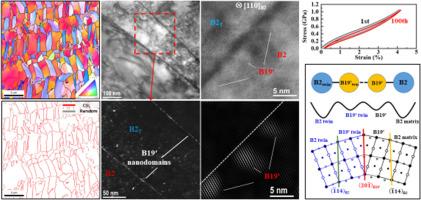一种具有独特性能的冷轧TiNi形状记忆合金B2中新的亚晶组织
IF 8.3
1区 材料科学
Q1 MATERIALS SCIENCE, MULTIDISCIPLINARY
引用次数: 0
摘要
塑性变形显著改变了TiNi形状记忆合金的组织和性能。本文研究了冷轧TiNi50.8 (at. 1)的B2相中具有扩展孪晶界的独特人字形亚晶结构的形成。%)及其对合金超弹性的影响。详细的电子背散射衍射(EBSD)分析表明,在冷轧变形过程中,经过多次道次后,在不同的方向上存在大量不同于基体晶粒的亚晶区。值得注意的是,在亚粒区域内出现了独特的带状和人字形结构,所有的边界都被确定为重合点阵(CSL)边界。进一步分析发现,在[100]B2取向晶粒中,周期性的<;011>;B2和<;001>;B2倾斜轴垂直于变形表面法线方向后,自发的CSL边界生成,形成了人字形结构内特有的四重结,不同于带状结构中发现的单一[011]B2倾斜轴。透射电镜(TEM)鉴定出B2孪晶关系对应于特殊的CSL Σ边界,而暗场和高角度环形暗场(HAADF)图像显示B19 '马氏体纳米畴装饰孪晶边界。这种扩展的孪晶界结构大大增强了循环稳定的超弹性,其特征是功能疲劳更有限,模量降低27%,可恢复应变增加76%,经过100次训练循环后,与固溶处理的样品相比。本研究为冷轧条件下TiNi sma的微观结构演变和超弹性性能的增强提供了新的见解,为通过简单的冷轧工艺引入具有马氏体-纳米畴嵌套B2孪晶的特殊亚晶结构来优化sma的功能提供了一种新方法。本文章由计算机程序翻译,如有差异,请以英文原文为准。


Novel sub-grain structures in B2 of a cold-rolled TiNi shape memory alloy with unique property
Plastic deformation significantly alters the microstructure and properties of TiNi shape memory alloys. This work investigates the formation of a unique herringbone-like sub-grain structure with extended twin boundaries in the B2 phase of a cold-rolled TiNi50.8 (at. %) and its impact on the superelasticity of the alloy. Detailed electron back-scatter diffraction (EBSD) analysis reveals abundant sub-grain areas in different orientations distinct from the matrix grain after multiple passes in cold-rolling deformation. Notably, unique band and herringbone structures emerge within the sub-grain areas, with all the boundaries identified as coincident site lattice (CSL) boundaries. Further analysis reveals spontaneous CSL boundary generation following periodic <011>B2 and <001>B2 tilt axes perpendicular to the normal direction of the deformed surface in [100]B2 oriented grains, forming a characteristic quadruple junction within the herringbone structure, distinct from the single [011]B2 tilt axis identified in the band structure. Transmission electron microscopy (TEM) identifies B2 twin relations corresponding to the special CSL Σ boundaries, while dark-field and high-angle annular dark-field (HAADF) images show B19′ martensitic nanodomains decorating the twin boundaries. This extended twin boundary structure enhances drastically cyclically stable superelasticity characterized by much more limited functional fatigue, 27 % lower modulus and 76 % larger recoverable strain as compared to the solution-treated sample after 100 training cycles. Our study provides new insights into the microstructure evolution and enhancement of the superelastic properties of TiNi SMAs by cold-rolling, offering a novel approach to optimize the functionality of SMAs by introducing special sub-grain structures with martensitic-nanodomains-nested B2 twins through simple cold-rolling process.
求助全文
通过发布文献求助,成功后即可免费获取论文全文。
去求助
来源期刊

Acta Materialia
工程技术-材料科学:综合
CiteScore
16.10
自引率
8.50%
发文量
801
审稿时长
53 days
期刊介绍:
Acta Materialia serves as a platform for publishing full-length, original papers and commissioned overviews that contribute to a profound understanding of the correlation between the processing, structure, and properties of inorganic materials. The journal seeks papers with high impact potential or those that significantly propel the field forward. The scope includes the atomic and molecular arrangements, chemical and electronic structures, and microstructure of materials, focusing on their mechanical or functional behavior across all length scales, including nanostructures.
 求助内容:
求助内容: 应助结果提醒方式:
应助结果提醒方式:


